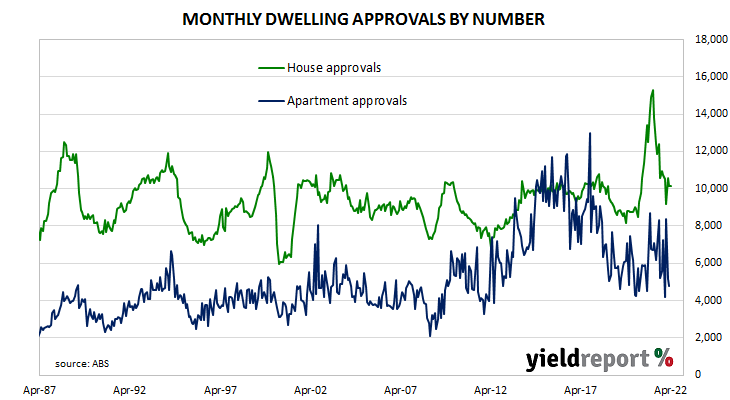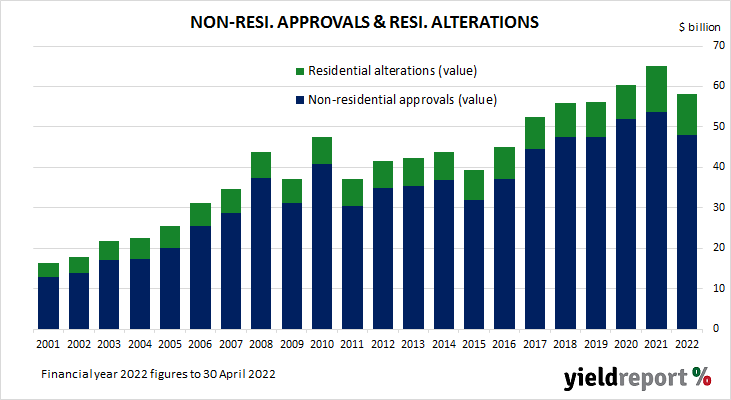Summary: Home approval numbers down 2.4% in April, below expectations; underlying conditions weakening; “big surge” in average value of approvals; house approvals up 0.4% by number, apartments down 7.9%; “pricing instability” in construction sector, rate increases behind slowing demand for developments; non-residential approvals down 0.9% in dollar terms, residential alterations down 1.3%.
Building approvals for dwellings, that is apartments and houses, had been heading south since mid-2018. As an indicator of investor confidence, falling approvals had presented a worrying signal, not just for the building sector but for the overall economy. However, approval figures from late-2019 and the early months of 2020 painted a picture of a recovery taking place, even as late as April of that year. Subsequent months’ figures then trended sharply upwards before falling back in 2021.
The Australian Bureau of Statistics has released the latest figures from April and total residential approvals declined by 2.4% on a seasonally-adjusted basis. The fall over the month contrasted with the 2.0% increase which had been generally expected but it was not as great as the 19.2% fall in March. Total approvals fell by 32.4% on an annual basis, slightly higher than the previous month’s revised figure of -35.2%. Monthly growth rates are often volatile.
“Dwelling approvals continued to move lower in April, coming in a touch under expectations but consistent with our prior that underlying conditions are weakening,” said Westpac senior economist Matthew Hassan.
Commonwealth Government bond yields rose significantly on the day. By the close of business, the 3-year ACGB yield had gained 8bps to 2.93% while 10-year and 20-year yields both finished 10bps higher at 3.37% and 3.69% respectively.
In the cash futures market, expectations of a steeper path for the actual cash rate over time firmed. At the end of the day, contract prices implied the cash rate, currently at 0.31%, would rise to 0.59% in June and then rise to 1.36% by August. May 2023 contracts implied a cash rate of 3.345%, 302bps above the current cash rate.
Hassan noted with concern “a big surge” in the average value of approvals. “Overall, the apparent cost-driven surge in approval values is troubling. With a large backlog of unprofitable work, steep cost and price increases, interest rate hikes and a housing markets entering a correction phase, the situation has the makings of a ‘perfect storm’ for Australia’s dwelling construction sector.
Approvals for new houses rose by 0.4% over the month after falling by 4.1% in March. On a 12-month basis, house approvals were 33.7% lower than they were in April 2021, down from March’s comparable figure of -32.1%.
Apartment approval figures are usually a lot more volatile and January’s total fell by 7.9% after a 38.3% drop in March. However, the 12-month growth figure improved from March’s revised rate of -40.5% to -29.5%.
“Pricing instability in the construction sector as well as expected increases in the cash rate may be behind the slowing in demand for unit developments,” said ANZ senior economist Adelaide Timbrell. “We expect further falls as rising interest rates hit finance availability for developers.”
Non-residential approvals declined by 0.9% in dollar terms over the month but increased by 49.6% on an annual basis. Figures in this segment also tend to be rather volatile.
Residential alteration approvals declined by 1.3% in dollar terms over the month and were 18.1% higher than in April 2021.



